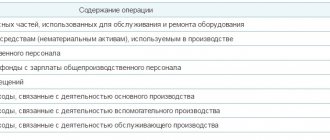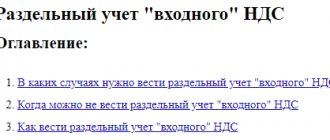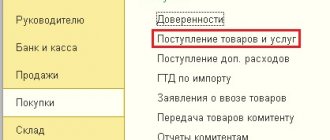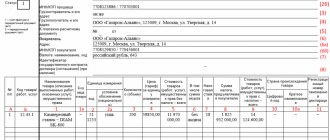The recipient of goods, works, services has the right to offset the amount of VAT for goods received, including fixed assets, intangible and biological assets, works and services, if they are used or will be used for the purposes of taxable turnover. To offset VAT amounts, the following conditions must be met:
- availability of an invoice from a VAT payer supplier;
- when importing from EAEU countries - reporting on indirect taxes is submitted, VAT is paid to the budget;
- when importing from countries other than the EAEU, customs clearance has been completed and VAT has been paid to the budget;
- when purchasing services from a non-resident, VAT is paid to the budget.
A person who is not a VAT payer has the right to offset VAT on the balance of goods (fixed assets, intangible assets, biological assets, real estate investments) as of the date of statement.
In the “Accounting 8 for Kazakhstan” configuration, data on the creditable part of VAT is collected in specialized registers.
- VAT recoverable
. This register is intended to account for “acquired” VAT. Entries in it are generated when posting documents for receipt of inventory, additional expenses, advance reports and other documents related to the acquisition of assets. - Adjustment of VAT for refund
. This register is intended to record transactions for adjusting VAT attributed to offset, which are subject to reflection in Appendix 300.06: for transactions provided for by the articles and the Tax Code of the Republic of Kazakhstan. - VAT, mutual settlements with the budget
. The register is intended to record the amounts of transferred value added tax credits.
In accordance with the data specified in the registers, a VAT declaration for the period is generated.
Example #1
It is necessary to distribute VAT in the amount of 40 rubles from the services received, which were used for the sale of goods with and without VAT. When registering the receipt, VAT was marked for distribution.
During the reporting period, goods were sold for 80 rubles with VAT and for 20 rubles without VAT.
In our example, 4/5 should be taken as a deduction, and 1/5 should be taken into account in the cost. Why in the document “Distribution of VAT” the third subconto 19 of the account will be changed from “Distributed”: for the VAT amount of 32 rubles to “Accepted for deduction”, and for the VAT amount of 8 rubles to “Taking into account in the cost”.
Methods for offsetting VAT
There are two main methods for crediting VAT. They differ in the order in which the procedure is performed. In total, there are proportional and separate methods, each of which it is advisable for the taxpayer to become familiar with.
For goods and works used for non-taxable turnover, VAT, which import suppliers must pay, is not considered a refund, except in certain cases. In the case of taxable and non-taxable turnover, the payment is attributed to compensation at the choice of the payer in a proportional or separate manner.
Payers of value added tax who use two methods of attributing fees to reimbursement during the tax period do not take into account the turnover for which a separate method is used when calculating the share of turnover in the total amount, unless otherwise established.
If the proportional method is used, which is applied for the purpose of taxable and non-taxable turnovers, the total amount of all turnovers is taken into account to determine the specific weight of the indicator in the total amount.
Proportional method
The nuances of filling out tax documentation depend on the method adopted. When using the proportional method, when preparing documents for the receipt of assets, it is required to indicate the total turnover. Using the separate method means that VAT on receipt of goods, works and services is accounted for separately.
Separate method
When deciding to use the separate method, the taxpayer must keep separate records for expenses and value added tax on goods. When using this method, the fee that can be taken as offset is determined as the amount of the fee on goods for taxable turnover.
Thus, the amount of funds to be offset is determined as a fee for taxable turnover, to which a contribution for general indicators is added. The specified method in the configuration must correspond to the one approved in accordance with the subject's accounting policy.
Example No. 2
Materials were purchased in the amount of 131.11 rubles (VAT 20 rubles). VAT is marked for distribution. 3/4 of them (VAT 15 rubles) were written off. 1/4 (VAT 5 rubles) remained in the warehouse unused.
During the reporting period, goods were sold for 80 rubles with VAT and for 20 rubles without VAT.
Please note that VAT on written-off materials and those remaining in the warehouse is included in the “VAT Distribution” document on different lines. For the remaining materials, the cost account will be the same as the account for the materials themselves (for example, 10.01). Decommissioned ones have 20 or 26, depending on your settings.
In the document “Creating Purchase Ledger Entries” these lines are combined again.
Procedure for crediting VAT for reimbursement ↑
The procedure to be followed if it is necessary to accept a VAT credit for reimbursement is stated in the tax legislation.
There are some differences depending on which payments will be eligible for VAT credit.
Application Form
When filling out an application, you must remember that it must be submitted along with your tax return. Or during an inspection.
Since it is precisely at these moments that it is necessary to notify the tax authorities about how the organization wants to use the VAT amount:
This is interesting: Replacement of rights after expiration in 2018-2019 through government services and MFC - what do you need to know?
use it to pay contributions (clause 7 of Article 176 of the Tax Code of the Russian Federation) or return it to your current account.
The application for VAT offset is drawn up in any form. It must only contain the following information:
- KBK VAT (if repayment is made for another federal tax).
- The amount of the amount accepted for offset (the Ministry of Finance considers this optional).
- Current account number if you need to return the amount to the organization.
- Name of the organization (as well as OGRN, INN, KPP) and its legal address.
- Name of the tax service.
For upcoming payments
To charge VAT to future payments, you must fill out an application accordingly and then attach it to the submitted tax return.
The application must indicate that the difference between the amount required to be paid and the funds transferred should be used to pay for upcoming payments.
After 10 days, the relevant services must make a decision on this issue. The organization is also notified of the decision in writing.
The application can also be submitted in electronic form with a qualified signature attached. This point is regulated by the wording of the Federal Law of June 29, 2012 No. 97-F3.
To pay off arrears on other debts
Repayment of arrears on any taxes or other payments does not require writing an application. This operation is carried out by the tax authorities independently, without the participation of the payer himself.
The relevant services are only obliged to notify the organization in writing of the decision made. This point is regulated by Art. No. 78 clause 1 of the Tax Code of the Russian Federation.
For upcoming VAT payments
The use of the difference in funds transferred to the budget, resulting from the payment of VAT, to pay for future payments is carried out only if there is a written application from the payer.
According to Art. 78 of the Tax Code, this taxpayer application must be sent by email.
A qualified electronic signature is required. The application can also be submitted in writing on paper.
Features of separate VAT accounting for fixed assets and intangible assets
Separate accounting of VAT on account 19 is carried out for all types of purchased assets, including fixed assets and intangible assets. When purchasing a fixed asset or intangible asset, the method of accounting for VAT is also indicated, and upon acceptance for accounting it can be adjusted. The distribution of VAT on fixed assets and intangible assets is made by the same document as for other assets. However, for fixed assets and intangible assets, the tax code provides for the possibility of distributing VAT based on the results of the month. If the VAT distribution document is entered for the 1st or 2nd month of the quarter, revenue will be calculated for the corresponding month, and VAT distribution will be made only for fixed assets and intangible assets accepted for accounting in the current month.
What else you need to know ↑
There are also many nuances regarding the attribution of VAT to offset. First of all, this concerns how VAT is accepted for offset: transactions and other points that reflect the operation in accounting.
There are some differences in the offset of value added tax under different forms of taxation (USN or general regime).
Reflection in accounting
Tax deductions related to VAT offset must be reflected in accounting. Since this point is regulated by order of the Ministry of Finance of Russia dated October 31, 2000 No. 94N.
It is most correct to record the offset VAT in a subaccount opened for each type of tax separately:
- offset of VAT on advance payments is taken into account in the subaccount, which is assigned to account No. 76;
- offset of value added tax on purchased assets - a separate sub-account is opened under account No. 19;
- offset of VAT from payment - reflected in the subaccount “Calculation of advances”.
This is interesting: Is it possible to pay state fees online (via the Internet)
When reflecting the offset of VAT in accounting, it is not advisable to make any mistakes, as this may lead to a desk audit.
Failure to comply with applicable laws may result in severe fines and even criminal prosecution.
Registration of credit for export/import
There are some features regarding the registration of offsets when exporting or importing:
- In this case, only tax residents of the Russian Federation - various organizations and individual entrepreneurs - have the right to apply for a VAT offset.
- To obtain credit in this case, a number of conditions must be met:
- VAT can be credited only if the goods fall into the category subject to value added tax (Chapter No. 21 of the Tax Code of the Russian Federation);
- if goods located on the territory of the Russian Federation are accepted for accounting accordingly;
- there must be documentary evidence that the organization has paid VAT;
- the entire tax amount must be reflected in the purchase ledger.
Also, all companies that have the right to deduct VAT (set it off or return it to the current account) can do this no earlier than 90 days after implementation - the procedure itself takes approximately 3 months.
Tax offset under the simplified tax system
According to current legislation, a taxpayer has the right to offset VAT when using a simplified taxation scheme.
Ch. No. 21 and No. 26.2 of the Tax Code of the Russian Federation state that when an individual entrepreneur (or other person) uses a simplified taxation scheme, he does not have the right to deduct value added tax.
But if a transition to a general VAT taxation scheme has been made (if this is a requirement of counterparties), it becomes possible to carry out an offset under the simplified tax system on absolutely legal grounds.
This point is covered in detail in Art. No. 346.25 clause 6.
Despite the legality of carrying out such operations, taking into account Art. No. 346, many courts do not take this into account.
Since, according to the opinion of the Constitutional Court (decision No. 62-o 01/22/2014), taking into account the fact that organizations operating under the simplified tax system are not recognized as VAT payers - they take into account the tax on the value of goods and.
Also, legislative norms provide for a significantly lower tax rate for those organizations that use the lost tax scheme (6%).
Also, according to Chapter 26.2 of the Tax Code of the Russian Federation, the taxpayer has the right to independently choose which taxation scheme to work under.
Changing the VAT accounting method
If, upon receipt of materials, one accounting method was indicated (for example, “Distribute”), and upon write-off, the accountant realized that it was necessary to “Accept for deduction,” then in the document “Request-invoice” you can indicate the desired method. It will be used for these materials.
ATTENTION ! You can change the VAT accounting method only before the VAT is distributed. This means that if you make a document “VAT Allocation” at the end of the quarter, the VAT of all materials received in this quarter will be distributed. And those that you wrote off, and those that are still in stock. This means that in the next quarter you will no longer be able to change the way VAT is written off for these materials.
How to keep separate VAT records: about drawing up proportions, a purchase book and the “five percent” rule
Proportion for VAT distribution: revenue with or without VAT?
Previously we were talking about direct costs.
But the organization also incurs indirect (general business) expenses, which are simultaneously involved in both taxable and non-VAT-taxable transactions. These are rent, fees, utility costs, etc. Here the accountant cannot immediately say to which subaccount of the 19th account to assign the amount of VAT included in these expenses. In such a situation, the amount of “input” tax must be determined by calculation, using the appropriate proportion. The proportion “is determined based on the cost of shipped goods (work, services), property rights, transactions for the sale of which are subject to taxation (exempt from taxation), in the total cost of goods (work, services), property rights shipped during the tax period.” The Tax Code does not explain exactly what cost of goods (work, services) should be taken when calculating the proportion: with VAT or without VAT? Of course, for non-taxable transactions, the proceeds do not include the amount of tax. But in taxable goods (works, .. What should an accountant do in this situation who is going to determine the proportion for the purpose of distributing input VAT?
Of course, it is more profitable for organizations to take into account the revenue indicator, which includes VAT. In this case, the “taxable share” will be larger, and accordingly, the amount of the tax deduction will be larger. But officials believe that organizations should take revenue without VAT. At the same time, they refer to the comparability of indicators (letter of the Ministry of Finance of Russia dated May 20, 2005 No. 03-06-05-04/137).
If we analyze the judicial practice on this issue, it is contradictory. Previously, courts often made decisions in favor of organizations (see, for example, the resolution of the Federal Antimonopoly Service of the West Siberian District dated 05/07/07 No. F04-2637/2007(33744-A45-42)). But last year, the Presidium of the Supreme Arbitration Court sided with the regulatory authorities (resolution of the Presidium of the Supreme Arbitration Court of the Russian Federation dated November 18, 2008 No. 7185/08). Therefore, we can say that the chances of organizations challenging the position of tax authorities are now low.
Proportion based on quarterly data: difficulties
As mentioned earlier, the proportion for VAT distribution is calculated based on revenue for the tax period. Previously, when the tax period was a month, there were no problems with separate accounting. But with the change in the tax period (instead of a month - a quarter), organizations began to have difficulties maintaining separate records. After all, the reporting period for accounting purposes is a month.
An illustrative example: a fixed asset (which will be involved in both types of activities) is purchased and accounted for in January. The accountant can distribute the amount of “input” VAT on it only based on the results of the 1st quarter, that is, in early April. This means that the organization will be able to determine the final cost of the object (which will include part of the “input” VAT) only in April. But the main product needs to arrive in January! And depreciation on it should begin in February.
It is incorrect to advise “holding back” the transfer of the value of an object from account 08 to account 01, since this will contradict both PBU 6/01 and Chapter 25 of the Tax Code. In addition, this approach will result in tax risks for property tax.
As a result, the question arises: where to put that part of the “input” VAT that is not subject to deduction, since it relates to a non-taxable activity? In a good way, it should be taken into account in the initial cost of the OS. But at the time of formation of the initial cost, the amount of the non-deductible part of VAT is unknown.
Proportion based on quarter data: optimal option
In our opinion, in the described situation, the best option is to revise the original cost “retrospectively” (that is, from January) and recalculate the depreciation amounts for February-March. For income tax purposes, such a recalculation will not have any special consequences, since the organization will submit its first income tax return only in April. And by that time, the correct amount of depreciation calculated from the adjusted original cost will be indicated there. True, this option is not very convenient for those who calculate income tax monthly based on actual profit.
In fact, the proposed option is very similar to the organization correcting a mistake. Of course, the accountant does not recalculate because he made a mistake (after all, he did everything correctly in January). However, in such a situation, we consider such actions of the accountant acceptable. After all, they will help to avoid violations of tax laws and tax risks. Although we note that PBU 6/01 in this case is still violated. But, unfortunately, an ideal option that would allow us to take into account all the rules (both accounting and tax) does not yet exist.
Some experts suggest calculating the proportion monthly, but we consider this approach risky. The Ministry of Finance has quite clearly expressed its opposition to this method. In official clarifications (letters dated June 26, 2008 No. 03-07-11/237, dated November 12, 2008 No. 03-07-07/121), the Ministry of Finance indicated: the proportion for calculating VAT amounts must be calculated according to the data of the current tax period, that is, quarter .
And some organizations even calculate the proportion based on revenue data for the previous quarter. They believe that by fixing this option in the accounting policy, they will protect themselves from claims from the Federal Tax Service. However, risks still exist. For example, the capital's tax authorities find this approach illegal (letter from the Federal Tax Service for Moscow dated December 29, 2007 No. 19-11/125469).
When should I enter data into the purchase book?
The issue with filling out the purchase book arises due to the fact that at the time of receiving an invoice from the supplier for expenses related to both taxable and non-taxable transactions, the proportion by which VAT is “split” is unknown. The fact is that in a normal situation, the “input” invoice is recorded in the purchase book immediately. In this case, chronology must be observed. But in this situation, organizations cannot use this procedure, since only that part of the “input” tax that relates to transactions subject to VAT should be included in the purchase book. And the accountant does not yet know this part at the time of receiving the invoice from the supplier. He can determine it only based on the results of the tax period, that is, based on the results of the quarter.
Some people record the invoice in the purchase ledger when they receive it, and then (on the last day of the quarter) record it again. But when re-registering, that part of the indicators that accounts for non-VAT-taxable transactions is minus. In principle, by resorting to this method, organizations do not risk anything, because ultimately the correct data will be included in the amount of tax deductions on the declaration.
But, according to paragraph 8 of the Rules (approved by Decree of the Government of the Russian Federation dated December 2, 2000 No. 914), registration of an invoice in the purchase book is made for the amount for which the taxpayer receives the right to a deduction and which is determined taking into account the provisions of paragraph 4 of Article 170 of the Tax Code . That is, the invoice must be registered once and in the part related to transactions subject to VAT. Since this “part” will only be known at the end of the quarter, such invoices must be recorded in the purchase ledger on the last day of the quarter.
The Five Percent Rule
The Tax Code of the Russian Federation has a very interesting provision that allows some organizations to deduct the entire tax, even if they carry out both taxable and non-VAT-taxable transactions. In paragraph nine of paragraph 4 of Article 170 of the Tax Code it is said: the taxpayer has the right not to keep separate records, provided that “the share of total costs for the production of goods (work, services), transactions for the sale of which are not subject to taxation, does not exceed 5 percent of the total value of the total production costs."
A phrase that is simple at first glance causes difficulties in application and negative tax consequences. So, before using the “five percent” rule, we advise you to carefully weigh all the pros and cons, realistically assessing the degree of tax risks in a particular situation.
Difficulties and disputes during tax audits arise due to the fact that the rule allowing not to keep separate records is not clearly stated. And the main question: who can apply the “five percent” rule?
Firstly, the paragraph in question deals exclusively with production costs. Thus, with a literal interpretation of this norm, we can conclude that trade organizations (including “imputers”) do not have the right to apply preferential provisions. This is exactly how some local tax officials reason.
However, the Ministry of Finance, in one of the clarifications regarding the application of the “five percent rule,” spoke in favor of organizations (letter dated January 29, 2008 No. 03-07-11/37). Officials indicated that this rule can also be applied to trading activities.
True, this letter dealt exclusively with trade organizations in general, and there was no stipulation that such organizations pay UTII. Therefore, it is possible that officials have not changed their minds regarding “imputed traders”: the “five percent” rule applies only to VAT payers. But UTII payers are not one of them. Therefore, they do not have the right to apply this rule (letters of the Ministry of Finance of Russia dated July 8, 2005 No. 03-04-11/143, Federal Tax Service of Russia dated May 31, 2005 No. 03-1-03/897/ [email protected] ).
The most interesting thing is that the Supreme Arbitration Court of the Russian Federation considered similar disputes that arose between tax authorities and “impostors”, and at different times issued different verdicts. The ruling of the Supreme Arbitration Court of the Russian Federation dated April 30, 2008 No. 3302/08 concluded: the five percent rule applies only to production costs for goods manufactured by the taxpayer. And if an organization is not a manufacturer of goods, but only sells them, being an “important” in relation to retail trade, it does not have the right to apply this rule. And in the ruling of the Supreme Arbitration Court of the Russian Federation dated August 15, 2008 No. 10210/08, the court expressed the opposite opinion, supporting the “imputed person.”
At the same time, we note that officials allow organizations providing services to use the “five percent” rule (letter of the Ministry of Finance of Russia dated February 22, 2007 No. 03-07-08/24).
Secondly, it is not clear which costs (direct only or direct and indirect) need to be taken into account to determine whether a company is complying with the five percent limit?
The answer to this question was given by the Russian Ministry of Finance in letter dated December 29, 2008 No. 03-07-11/387. It says that when determining the specified 5 percent indicator of total costs, both direct costs for the production and sale of goods (works, services), and other costs associated with the production and sale of these goods and services are taken into account.








